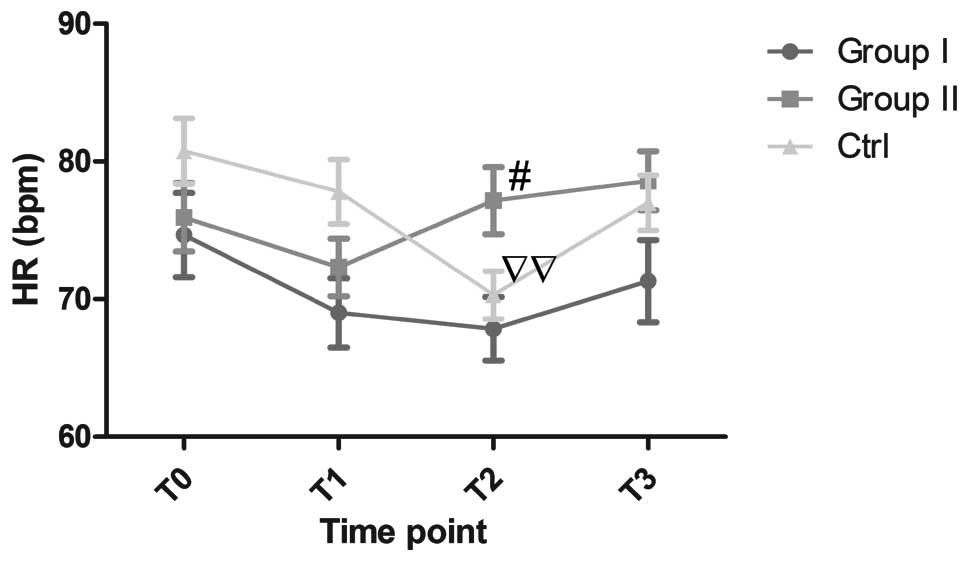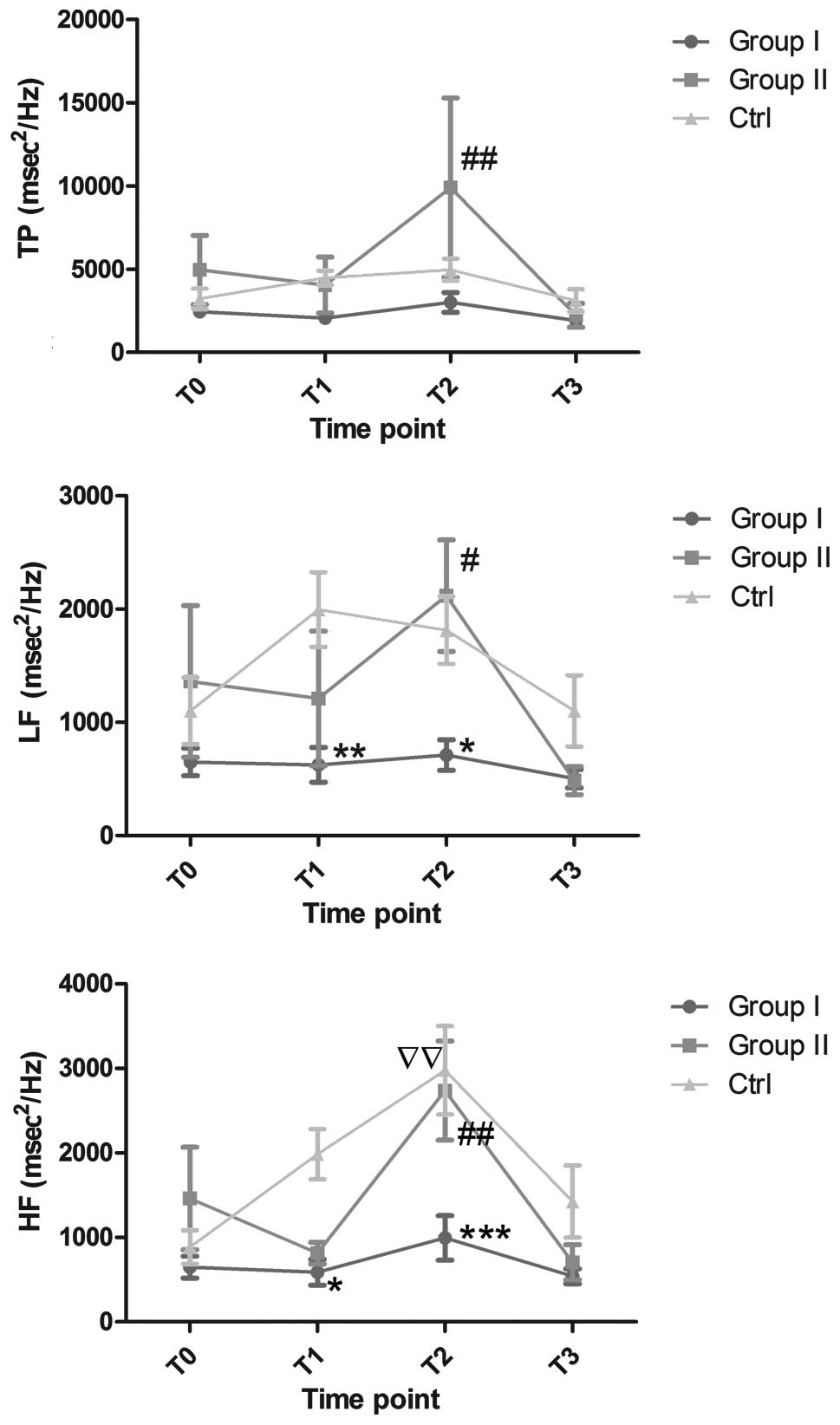|
1
|
Xiao HT, Liao Z and Tong RS: Penehyclidine
hydrochloride: a potential drug for treating COPD by attenuating
Toll-like receptors. Drug Des Devel Ther. 6:317–322. 2012.
View Article : Google Scholar : PubMed/NCBI
|
|
2
|
Wang J, Ren Y, Zhu Y, et al: Effect of
penehyclidine hydrochloride on the incidence of intra-operative
awareness in Chinese patients undergoing breast cancer surgery
during general anaesthesia. Anaesthesia. 68:136–141. 2013.
View Article : Google Scholar : PubMed/NCBI
|
|
3
|
Sun YJ, Song DD, Diao YG, Zhou J and Zhang
TZ: Penehyclidine hydrochloride preserves the intestinal barrier
function in patients undergoing cardiopulmonary bypass. J Thorac
Cardiovasc Surg. 146:179–185. 2013. View Article : Google Scholar : PubMed/NCBI
|
|
4
|
Patterson TA, Lipton JR, Bennett EL and
Rosenzweig MR: Cholinergic receptor antagonists impair formation of
intermediate-term memory in the chick. Behav Neural Biol. 54:63–74.
1990. View Article : Google Scholar : PubMed/NCBI
|
|
5
|
Rossman AC: The physiology of the
nicotinic acetylcholine receptor and its importance in the
administration of anesthesia. AANA J. 79:433–440. 2011.PubMed/NCBI
|
|
6
|
Harvey RD: Muscarinic receptor agonists
and antagonists: effects on cardiovascular function. Handb Exp
Pharmacol. 299–316. 2012.PubMed/NCBI
|
|
7
|
Xiao HT, Liao Z, Meng XM, Yan XY, Chen SJ
and Mo ZJ: Underlying mechanism of penehyclidine hydrochloride on
isolated rat uterus. Fundam Clin Pharmacol. 23:419–421. 2009.
View Article : Google Scholar : PubMed/NCBI
|
|
8
|
Zhang Z, Zhuang Y, Ouyang F, Zhang A, Zeng
B and Gu M: Penehyclidine enhances the efficacy of tropisetron in
prevention of PONV following gynecological laparoscopic surgery. J
Anesth. 26:864–869. 2012. View Article : Google Scholar : PubMed/NCBI
|
|
9
|
No authors listed. Heart rate variability.
Standards of measurement, physiological interpretation and clinical
use. Task Force of the European Society of Cardiology and the North
American Society of Pacing and Electrophysiology. Eur Heart J.
17:354–381. 1996. View Article : Google Scholar : PubMed/NCBI
|
|
10
|
Akselrod S, Gordon D, Ubel FA, Shannon DC,
Berger AC and Cohen RJ: Power spectrum analysis of heart rate
fluctuation: a quantitative probe of beat-to-beat cardiovascular
control. Science. 213:220–222. 1981. View Article : Google Scholar : PubMed/NCBI
|
|
11
|
Di Iorio C, Cafiero T and Di Minno RM: The
effects of pneumoperitoneum and head-up position on heart rate
variability and QT interval dispersion during laparoscopic
cholecystectomy. Minerva Anestesiol. 76:882–889. 2010.PubMed/NCBI
|
|
12
|
Sugiura H, Chinushi M, Komura S, Hirono T
and Aizawa Y: Heart rate variability is a useful parameter for
evaluation of anticholinergic effect associated with inducibility
of atrial fibrillation. Pacing Clin Electrophysiol. 28:1208–1214.
2005. View Article : Google Scholar : PubMed/NCBI
|
|
13
|
Fujiwara Y, Kurokawa S, Shibata Y, Asakura
Y, Harado M and Komatsu T: Sympathovagal effects of spinal
anaesthesia with intrathecal or intravenous fentanyl assessed by
heart rate variability. Acta Anaesthesiol Scand. 53:476–482. 2009.
View Article : Google Scholar : PubMed/NCBI
|
|
14
|
No authors listed. Heart rate variability:
standards of measurement, physiological interpretation and clinical
use. Task Force of the European Society of Cardiology and the North
American Society of Pacing and Electrophysiology. Circulation.
93:1043–1065. 1996. View Article : Google Scholar : PubMed/NCBI
|
|
15
|
Banz VM, Jakob SM and Inderbitzin D:
Review article: improving outcome after major surgery:
pathophysiological considerations. Anesth Analg. 112:1147–1155.
2011. View Article : Google Scholar : PubMed/NCBI
|
|
16
|
Riznyk L, Fijałkowska M and Przesmycki K:
Effects of thiopental and propofol on heart rate variability during
fentanyl-based induction of general anesthesia. Pharmacol Rep.
57:128–134. 2005.PubMed/NCBI
|
|
17
|
Lowe NK: The nature of labor pain. Am J
Obstet Gynecol. 186:(5 Suppl Nature). S16–S24. 2002. View Article : Google Scholar : PubMed/NCBI
|
|
18
|
Alici G, Ozkan B, Acar G, et al:
Evaluation of autonomic functions by heart rate variability after
stenting in patients with carotid artery stenosis. Ann Noninvasive
Electrocardiol. 18:126–129. 2013. View Article : Google Scholar : PubMed/NCBI
|
|
19
|
Sato R, Mizuno M, Miura T, et al:
Angiotensin receptor blockers regulate the synchronization of
circadian rhythms in heart rate and blood pressure. J Hypertens.
31:1233–1238. 2013. View Article : Google Scholar : PubMed/NCBI
|
|
20
|
Kaneshiro B, Grimes DA and Lopez LM: Pain
management for tubal sterilization by hysteroscopy. Cochrane
Database Syst Rev. 8:CD0092512012.PubMed/NCBI
|
|
21
|
Griffis CA, Crabb Breen E, Compton P, et
al: Acute painful stress and inflammatory mediator production.
Neuroimmunomodulation. 20:127–133. 2013. View Article : Google Scholar : PubMed/NCBI
|
|
22
|
Florio P, Puzzutiello R, Filippeschi M, et
al: Low-dose spinal anesthesia with hyperbaric bupivacaine with
intrathecal fentanyl for operative hysteroscopy: a case series
study. J Minim Invasive Gynecol. 19:107–112. 2012. View Article : Google Scholar : PubMed/NCBI
|
|
23
|
Cesur M, Alici HA, Erdem AF, Borekci B and
Silbir F: Spinal anesthesia with sequential administration of plain
and hyperbaric bupivacaine provides satisfactory analgesia with
hemodynamic stability in cesarean section. Int J Obstet Anesth.
17:217–222. 2008. View Article : Google Scholar : PubMed/NCBI
|
|
24
|
Guo SB, Lin M and Hao ZB: The application
of combination of spinal anesthesia and intraveous anesthesia in
gynecological laproscopy. Zhong Guo Xian Dai Yao Wu Ying Yong.
3:902009.(In Chinese).
|
|
25
|
Geffin B and Shapiro L: Sinus bradycardia
and asystole during spinal and epidural anesthesia: a report of 13
cases. J Clin Anesth. 10:278–285. 1998. View Article : Google Scholar : PubMed/NCBI
|
|
26
|
Lesser JB, Sanborn KV, Valskys R and
Kuroda M: Severe bradycardia during spinal and epidural anesthesia
recorded by an anesthesia information management system.
Anesthesiology. 99:859–866. 2003. View Article : Google Scholar : PubMed/NCBI
|
|
27
|
Malliani A, Pagani M, Lombardi F and
Cerutti S: Cardiovascular neural regulation explored in the
frequency domain. Circulation. 84:482–492. 1991. View Article : Google Scholar : PubMed/NCBI
|
|
28
|
Carr DB and Goudas LC: Acute pain. Lancet.
353:2051–2058. 1999. View Article : Google Scholar : PubMed/NCBI
|
|
29
|
Weissman A, Torkhov O, Weissman AI and
Drugan A: The effects of meperidine and epidural analgesia in labor
on maternal heart rate variability. Int J Obstet Anesth.
18:118–124. 2009. View Article : Google Scholar : PubMed/NCBI
|
|
30
|
Hanss R, Ohnesorge H, Kaufmann M, et al:
Changes in heart rate variability may reflect sympatholysis during
spinal anaesthesia. Acta Anaesthesiol Scand. 51:1297–1304. 2007.
View Article : Google Scholar : PubMed/NCBI
|
|
31
|
Nakatsuka I, Ochiai R and Takeda J:
Changes in heart rate variability in sevoflurane and nitrous oxide
anesthesia: effects of respiration and depth of anesthesia. J Clin
Anesth. 14:196–200. 2002. View Article : Google Scholar : PubMed/NCBI
|
|
32
|
Fujiwara Y, Sato Y, Shibata Y, Asakura Y,
Nishiwaki K and Komatsu T: A greater decrease in blood pressure
after spinal anaesthesia in patients with low entropy of the RR
interval. Acta Anaesthesiol Scand. 51:1161–1165. 2007.PubMed/NCBI
|
|
33
|
Haney MF and Wiklund U: Can heart rate
variability become a screening tool for anesthesia-related
hypotension? Acta Anaesthesiol Scand. 51:1289–1291. 2007.
View Article : Google Scholar : PubMed/NCBI
|
|
34
|
Vettorello M, Colombo R, De Grandis CE,
Costantini E and Raimondi F: Effect of fentanyl on heart rate
variability during spontaneous and paced breathing in healthy
volunteers. Acta Anaesthesiol Scand. 52:1064–1070. 2008. View Article : Google Scholar : PubMed/NCBI
|
|
35
|
Parati G, Mancia G, Di Rienzo M and
Castiglioni P: Point: cardiovascular variability is/is not an index
of autonomic control of circulation. J Appl Physiol (1985).
101:676–678; discussion 681–682. 2006. View Article : Google Scholar : PubMed/NCBI
|












